Analysis of Management Accounting and Control at Lazy King Ltd
VerifiedAdded on 2021/02/22
|15
|4796
|175
Report
AI Summary
This report focuses on management accounting and control systems, using Lazy King Ltd., a plastic chair manufacturer, as a case study. Task 1 analyzes production plans to maximize weekly profit and evaluates cost reduction strategies using Economic Order Quantity (EOQ), Margin of Safety, and Just-in-Time methods. It includes a profit statement and recommendations for increasing production. Task 2 examines different investment options, analyzing Net Present Value (NPV) and discussing the benefits, limitations, and dysfunctional consequences of financial performance measures. The report also explores the Balance Scorecard (BSC) to reduce short-term orientation, providing a comprehensive overview of management accounting principles and their application in real-world business scenarios.
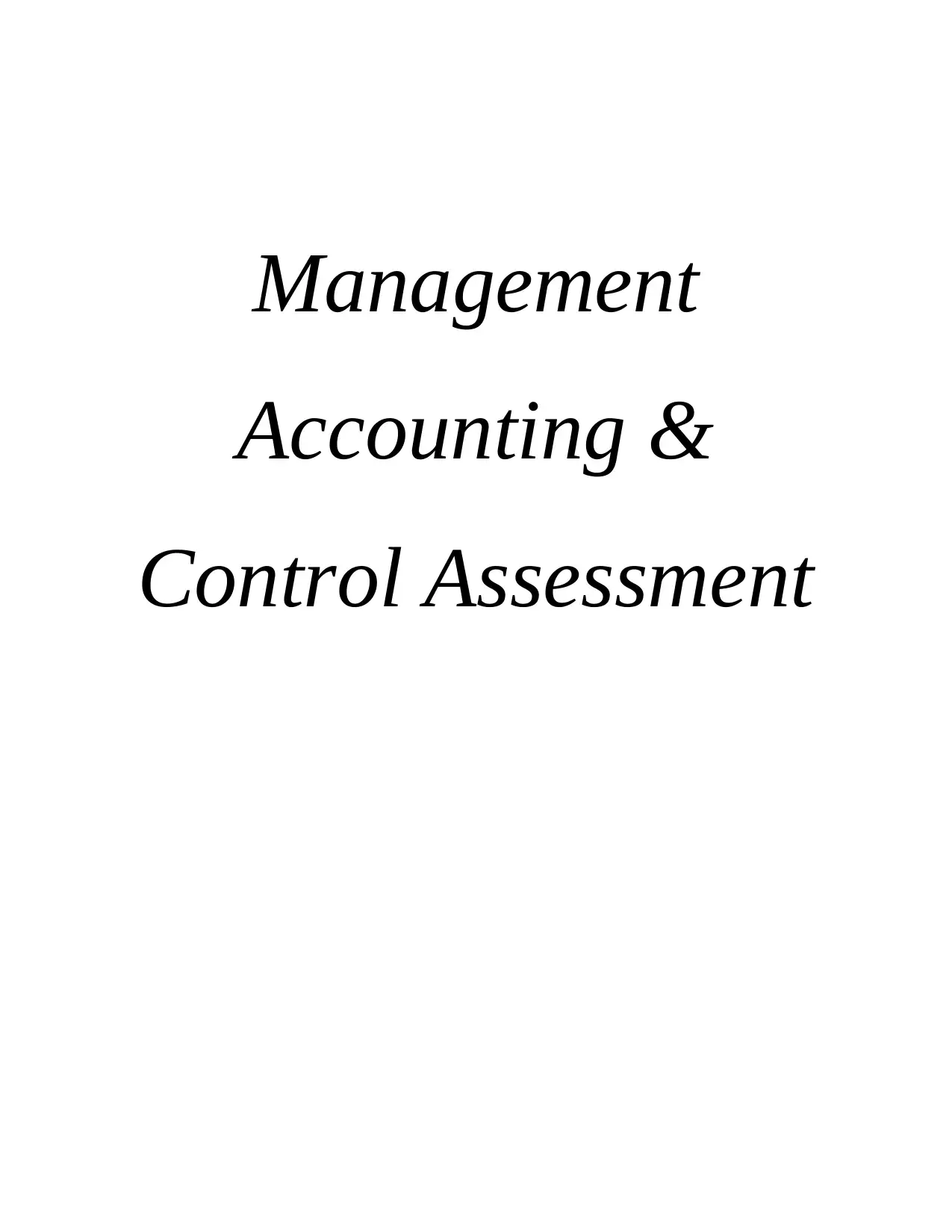
Management
Accounting &
Control Assessment
Accounting &
Control Assessment
Paraphrase This Document
Need a fresh take? Get an instant paraphrase of this document with our AI Paraphraser
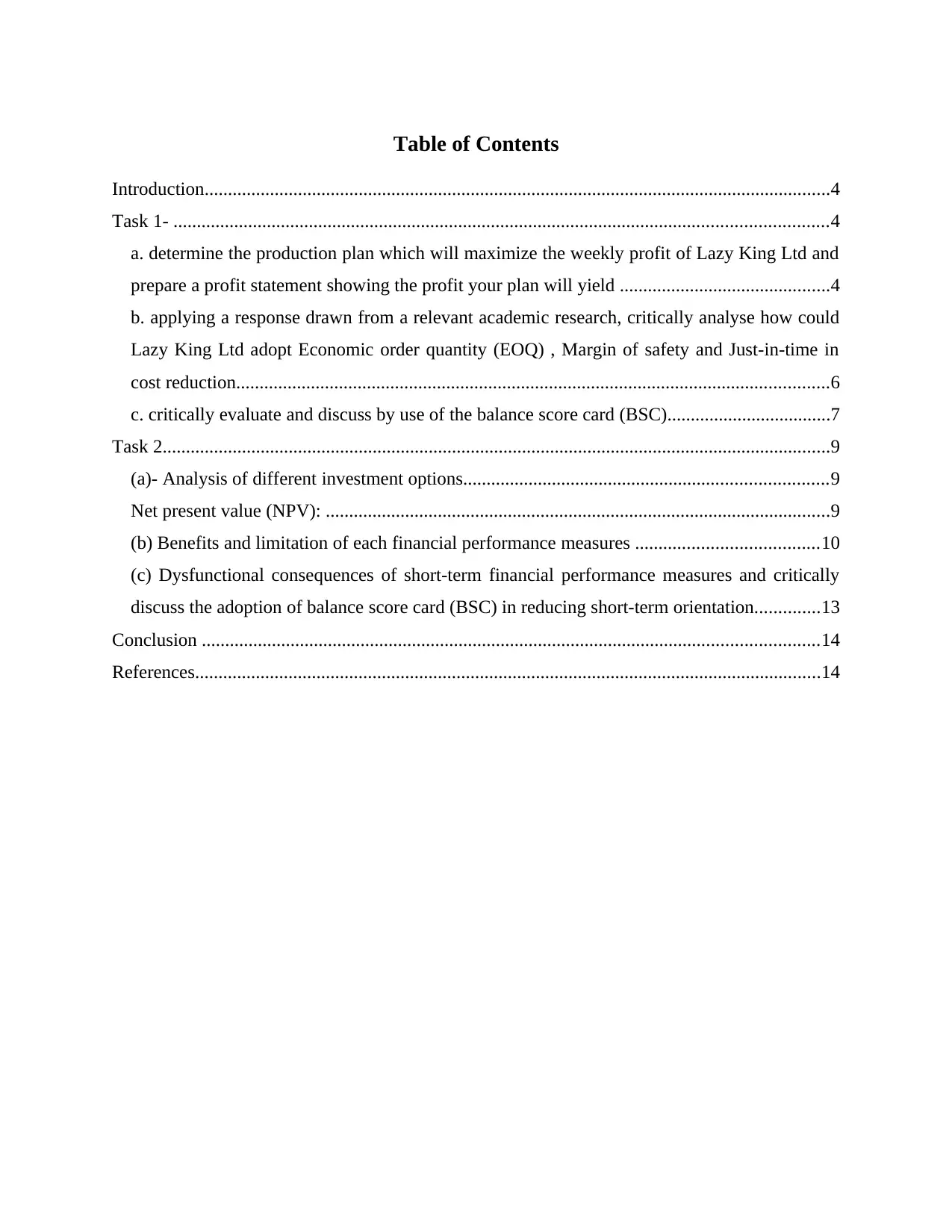
Table of Contents
Introduction......................................................................................................................................4
Task 1- ............................................................................................................................................4
a. determine the production plan which will maximize the weekly profit of Lazy King Ltd and
prepare a profit statement showing the profit your plan will yield .............................................4
b. applying a response drawn from a relevant academic research, critically analyse how could
Lazy King Ltd adopt Economic order quantity (EOQ) , Margin of safety and Just-in-time in
cost reduction...............................................................................................................................6
c. critically evaluate and discuss by use of the balance score card (BSC)...................................7
Task 2...............................................................................................................................................9
(a)- Analysis of different investment options..............................................................................9
Net present value (NPV): ............................................................................................................9
(b) Benefits and limitation of each financial performance measures .......................................10
(c) Dysfunctional consequences of short-term financial performance measures and critically
discuss the adoption of balance score card (BSC) in reducing short-term orientation..............13
Conclusion ....................................................................................................................................14
References......................................................................................................................................14
Introduction......................................................................................................................................4
Task 1- ............................................................................................................................................4
a. determine the production plan which will maximize the weekly profit of Lazy King Ltd and
prepare a profit statement showing the profit your plan will yield .............................................4
b. applying a response drawn from a relevant academic research, critically analyse how could
Lazy King Ltd adopt Economic order quantity (EOQ) , Margin of safety and Just-in-time in
cost reduction...............................................................................................................................6
c. critically evaluate and discuss by use of the balance score card (BSC)...................................7
Task 2...............................................................................................................................................9
(a)- Analysis of different investment options..............................................................................9
Net present value (NPV): ............................................................................................................9
(b) Benefits and limitation of each financial performance measures .......................................10
(c) Dysfunctional consequences of short-term financial performance measures and critically
discuss the adoption of balance score card (BSC) in reducing short-term orientation..............13
Conclusion ....................................................................................................................................14
References......................................................................................................................................14
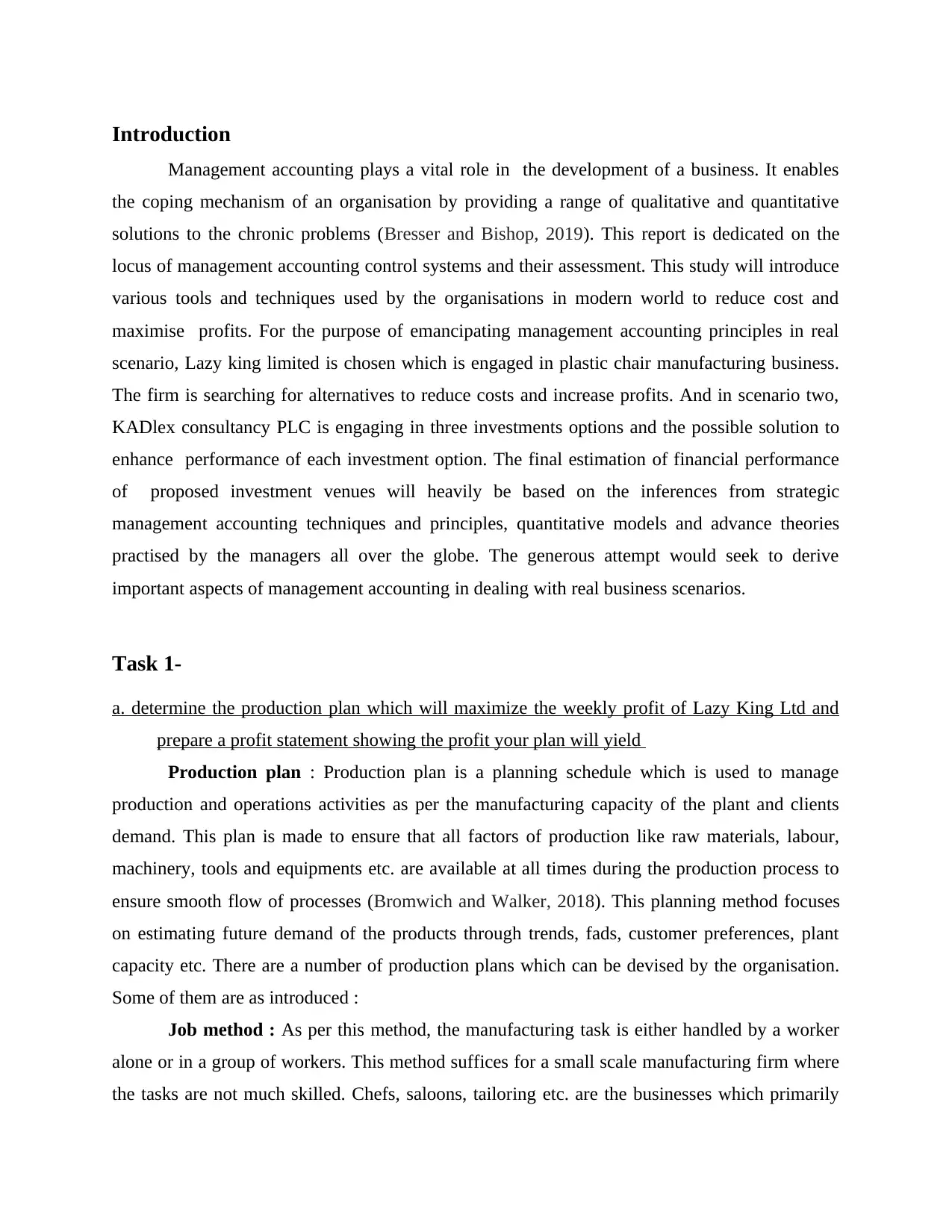
Introduction
Management accounting plays a vital role in the development of a business. It enables
the coping mechanism of an organisation by providing a range of qualitative and quantitative
solutions to the chronic problems (Bresser and Bishop, 2019). This report is dedicated on the
locus of management accounting control systems and their assessment. This study will introduce
various tools and techniques used by the organisations in modern world to reduce cost and
maximise profits. For the purpose of emancipating management accounting principles in real
scenario, Lazy king limited is chosen which is engaged in plastic chair manufacturing business.
The firm is searching for alternatives to reduce costs and increase profits. And in scenario two,
KADlex consultancy PLC is engaging in three investments options and the possible solution to
enhance performance of each investment option. The final estimation of financial performance
of proposed investment venues will heavily be based on the inferences from strategic
management accounting techniques and principles, quantitative models and advance theories
practised by the managers all over the globe. The generous attempt would seek to derive
important aspects of management accounting in dealing with real business scenarios.
Task 1-
a. determine the production plan which will maximize the weekly profit of Lazy King Ltd and
prepare a profit statement showing the profit your plan will yield
Production plan : Production plan is a planning schedule which is used to manage
production and operations activities as per the manufacturing capacity of the plant and clients
demand. This plan is made to ensure that all factors of production like raw materials, labour,
machinery, tools and equipments etc. are available at all times during the production process to
ensure smooth flow of processes (Bromwich and Walker, 2018). This planning method focuses
on estimating future demand of the products through trends, fads, customer preferences, plant
capacity etc. There are a number of production plans which can be devised by the organisation.
Some of them are as introduced :
Job method : As per this method, the manufacturing task is either handled by a worker
alone or in a group of workers. This method suffices for a small scale manufacturing firm where
the tasks are not much skilled. Chefs, saloons, tailoring etc. are the businesses which primarily
Management accounting plays a vital role in the development of a business. It enables
the coping mechanism of an organisation by providing a range of qualitative and quantitative
solutions to the chronic problems (Bresser and Bishop, 2019). This report is dedicated on the
locus of management accounting control systems and their assessment. This study will introduce
various tools and techniques used by the organisations in modern world to reduce cost and
maximise profits. For the purpose of emancipating management accounting principles in real
scenario, Lazy king limited is chosen which is engaged in plastic chair manufacturing business.
The firm is searching for alternatives to reduce costs and increase profits. And in scenario two,
KADlex consultancy PLC is engaging in three investments options and the possible solution to
enhance performance of each investment option. The final estimation of financial performance
of proposed investment venues will heavily be based on the inferences from strategic
management accounting techniques and principles, quantitative models and advance theories
practised by the managers all over the globe. The generous attempt would seek to derive
important aspects of management accounting in dealing with real business scenarios.
Task 1-
a. determine the production plan which will maximize the weekly profit of Lazy King Ltd and
prepare a profit statement showing the profit your plan will yield
Production plan : Production plan is a planning schedule which is used to manage
production and operations activities as per the manufacturing capacity of the plant and clients
demand. This plan is made to ensure that all factors of production like raw materials, labour,
machinery, tools and equipments etc. are available at all times during the production process to
ensure smooth flow of processes (Bromwich and Walker, 2018). This planning method focuses
on estimating future demand of the products through trends, fads, customer preferences, plant
capacity etc. There are a number of production plans which can be devised by the organisation.
Some of them are as introduced :
Job method : As per this method, the manufacturing task is either handled by a worker
alone or in a group of workers. This method suffices for a small scale manufacturing firm where
the tasks are not much skilled. Chefs, saloons, tailoring etc. are the businesses which primarily
⊘ This is a preview!⊘
Do you want full access?
Subscribe today to unlock all pages.

Trusted by 1+ million students worldwide
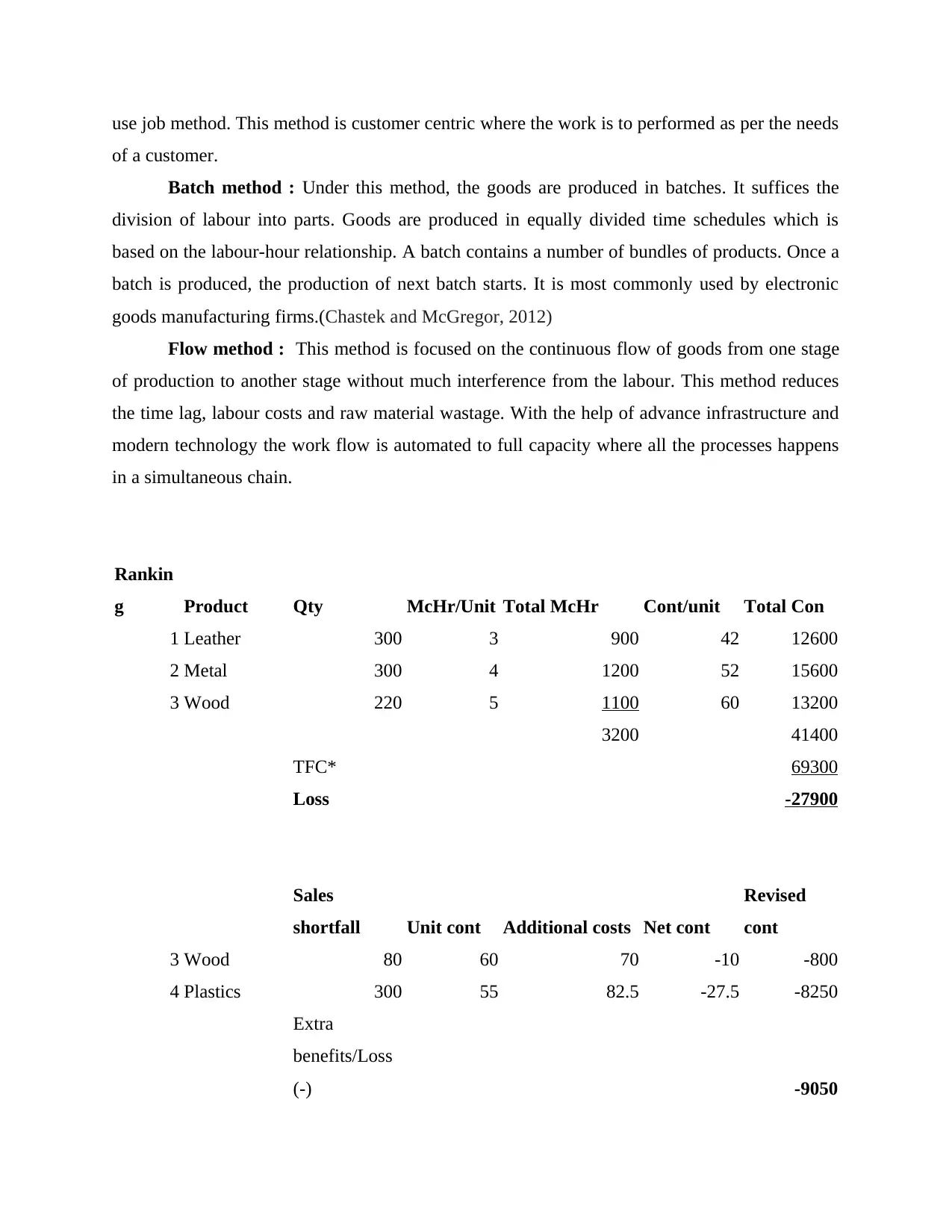
use job method. This method is customer centric where the work is to performed as per the needs
of a customer.
Batch method : Under this method, the goods are produced in batches. It suffices the
division of labour into parts. Goods are produced in equally divided time schedules which is
based on the labour-hour relationship. A batch contains a number of bundles of products. Once a
batch is produced, the production of next batch starts. It is most commonly used by electronic
goods manufacturing firms.(Chastek and McGregor, 2012)
Flow method : This method is focused on the continuous flow of goods from one stage
of production to another stage without much interference from the labour. This method reduces
the time lag, labour costs and raw material wastage. With the help of advance infrastructure and
modern technology the work flow is automated to full capacity where all the processes happens
in a simultaneous chain.
Rankin
g Product Qty McHr/Unit Total McHr Cont/unit Total Con
1 Leather 300 3 900 42 12600
2 Metal 300 4 1200 52 15600
3 Wood 220 5 1100 60 13200
3200 41400
TFC* 69300
Loss -27900
Sales
shortfall Unit cont Additional costs Net cont
Revised
cont
3 Wood 80 60 70 -10 -800
4 Plastics 300 55 82.5 -27.5 -8250
Extra
benefits/Loss
(-) -9050
of a customer.
Batch method : Under this method, the goods are produced in batches. It suffices the
division of labour into parts. Goods are produced in equally divided time schedules which is
based on the labour-hour relationship. A batch contains a number of bundles of products. Once a
batch is produced, the production of next batch starts. It is most commonly used by electronic
goods manufacturing firms.(Chastek and McGregor, 2012)
Flow method : This method is focused on the continuous flow of goods from one stage
of production to another stage without much interference from the labour. This method reduces
the time lag, labour costs and raw material wastage. With the help of advance infrastructure and
modern technology the work flow is automated to full capacity where all the processes happens
in a simultaneous chain.
Rankin
g Product Qty McHr/Unit Total McHr Cont/unit Total Con
1 Leather 300 3 900 42 12600
2 Metal 300 4 1200 52 15600
3 Wood 220 5 1100 60 13200
3200 41400
TFC* 69300
Loss -27900
Sales
shortfall Unit cont Additional costs Net cont
Revised
cont
3 Wood 80 60 70 -10 -800
4 Plastics 300 55 82.5 -27.5 -8250
Extra
benefits/Loss
(-) -9050
Paraphrase This Document
Need a fresh take? Get an instant paraphrase of this document with our AI Paraphraser

BLHr F/Ohd
3850 18
W1 Cost analysis
P W wood plastics
SP 1 1 200 220
VC 0.75 0.7 140 165
Cont 0.25 0.3 60 55
W2
Overtime/
Additional cost
DL/Unit V/Ohd Add cost
% 0.4 0.1
Wood 56 14 70
Pastics 66 16.5 82.5
Recommendation : Lazy king Ltd., is a plastic chair manufacturer looking for the
alternatives to reduce production costs. Since all its business segments are turning into a loss
making entity, the recommendation would be that it should increase its production quantities to
450 for all products, because at this point it will be able to achieve break even point where the
costs incurred will be covered and the firm will be in a zero loss zero profit state. The production
beyond 450 quantity per division the business will bear profits for the firm. It needs to sell more
because its prices are fixed and it can't go for increasing prices because that will be fatal for the
business. As it is a loss making entity as of now, it shall go for the obvious route of selling more.
b. applying a response drawn from a relevant academic research, critically analyse how could
Lazy King Ltd adopt Economic order quantity (EOQ) , Margin of safety and Just-in-time
in cost reduction.
Economic order quantity : It is the optimum amount of a product to be purchased at a
time in order to reduce the annual costs of carrying and ordering the product in stocks. It is also
referred as optimum lot size.
3850 18
W1 Cost analysis
P W wood plastics
SP 1 1 200 220
VC 0.75 0.7 140 165
Cont 0.25 0.3 60 55
W2
Overtime/
Additional cost
DL/Unit V/Ohd Add cost
% 0.4 0.1
Wood 56 14 70
Pastics 66 16.5 82.5
Recommendation : Lazy king Ltd., is a plastic chair manufacturer looking for the
alternatives to reduce production costs. Since all its business segments are turning into a loss
making entity, the recommendation would be that it should increase its production quantities to
450 for all products, because at this point it will be able to achieve break even point where the
costs incurred will be covered and the firm will be in a zero loss zero profit state. The production
beyond 450 quantity per division the business will bear profits for the firm. It needs to sell more
because its prices are fixed and it can't go for increasing prices because that will be fatal for the
business. As it is a loss making entity as of now, it shall go for the obvious route of selling more.
b. applying a response drawn from a relevant academic research, critically analyse how could
Lazy King Ltd adopt Economic order quantity (EOQ) , Margin of safety and Just-in-time
in cost reduction.
Economic order quantity : It is the optimum amount of a product to be purchased at a
time in order to reduce the annual costs of carrying and ordering the product in stocks. It is also
referred as optimum lot size.
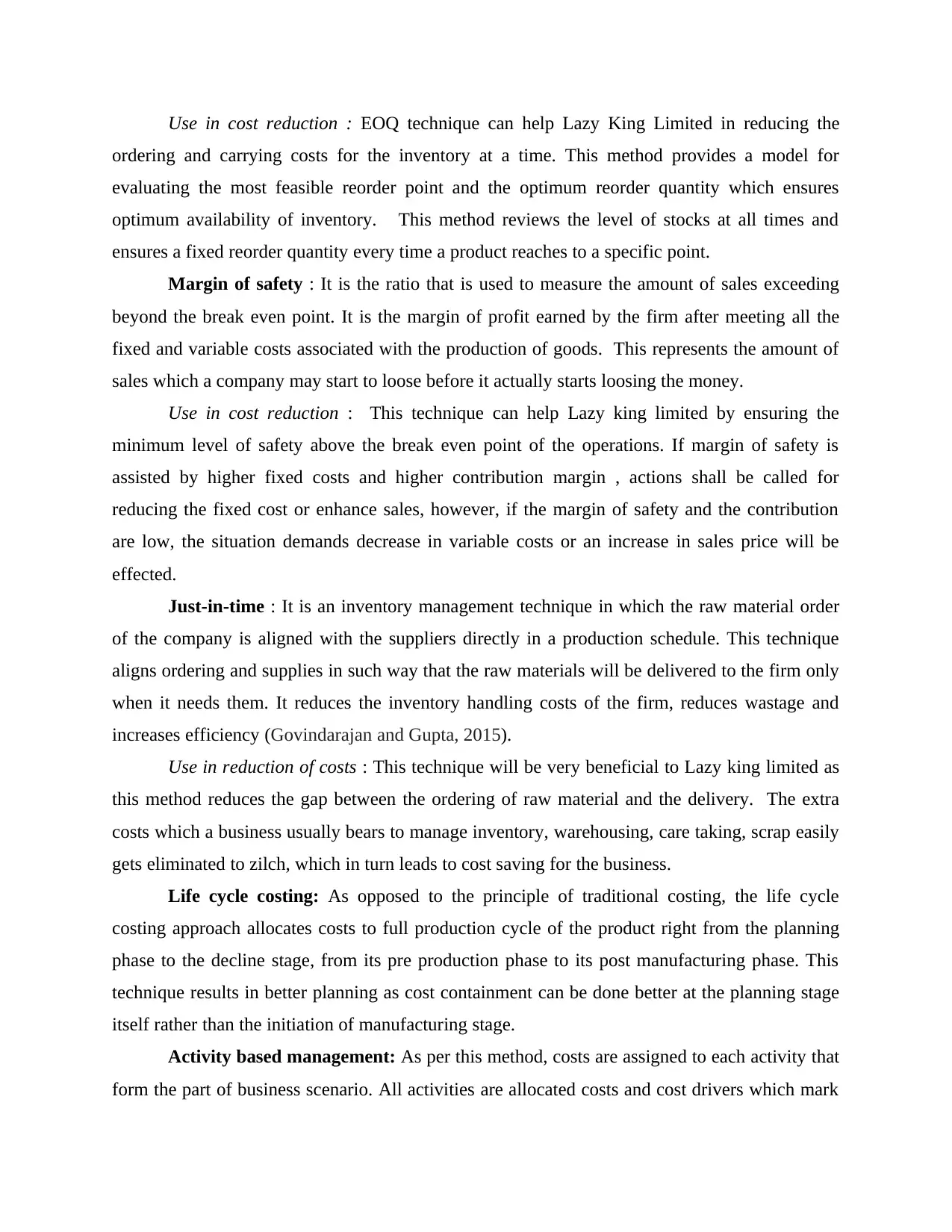
Use in cost reduction : EOQ technique can help Lazy King Limited in reducing the
ordering and carrying costs for the inventory at a time. This method provides a model for
evaluating the most feasible reorder point and the optimum reorder quantity which ensures
optimum availability of inventory. This method reviews the level of stocks at all times and
ensures a fixed reorder quantity every time a product reaches to a specific point.
Margin of safety : It is the ratio that is used to measure the amount of sales exceeding
beyond the break even point. It is the margin of profit earned by the firm after meeting all the
fixed and variable costs associated with the production of goods. This represents the amount of
sales which a company may start to loose before it actually starts loosing the money.
Use in cost reduction : This technique can help Lazy king limited by ensuring the
minimum level of safety above the break even point of the operations. If margin of safety is
assisted by higher fixed costs and higher contribution margin , actions shall be called for
reducing the fixed cost or enhance sales, however, if the margin of safety and the contribution
are low, the situation demands decrease in variable costs or an increase in sales price will be
effected.
Just-in-time : It is an inventory management technique in which the raw material order
of the company is aligned with the suppliers directly in a production schedule. This technique
aligns ordering and supplies in such way that the raw materials will be delivered to the firm only
when it needs them. It reduces the inventory handling costs of the firm, reduces wastage and
increases efficiency (Govindarajan and Gupta, 2015).
Use in reduction of costs : This technique will be very beneficial to Lazy king limited as
this method reduces the gap between the ordering of raw material and the delivery. The extra
costs which a business usually bears to manage inventory, warehousing, care taking, scrap easily
gets eliminated to zilch, which in turn leads to cost saving for the business.
Life cycle costing: As opposed to the principle of traditional costing, the life cycle
costing approach allocates costs to full production cycle of the product right from the planning
phase to the decline stage, from its pre production phase to its post manufacturing phase. This
technique results in better planning as cost containment can be done better at the planning stage
itself rather than the initiation of manufacturing stage.
Activity based management: As per this method, costs are assigned to each activity that
form the part of business scenario. All activities are allocated costs and cost drivers which mark
ordering and carrying costs for the inventory at a time. This method provides a model for
evaluating the most feasible reorder point and the optimum reorder quantity which ensures
optimum availability of inventory. This method reviews the level of stocks at all times and
ensures a fixed reorder quantity every time a product reaches to a specific point.
Margin of safety : It is the ratio that is used to measure the amount of sales exceeding
beyond the break even point. It is the margin of profit earned by the firm after meeting all the
fixed and variable costs associated with the production of goods. This represents the amount of
sales which a company may start to loose before it actually starts loosing the money.
Use in cost reduction : This technique can help Lazy king limited by ensuring the
minimum level of safety above the break even point of the operations. If margin of safety is
assisted by higher fixed costs and higher contribution margin , actions shall be called for
reducing the fixed cost or enhance sales, however, if the margin of safety and the contribution
are low, the situation demands decrease in variable costs or an increase in sales price will be
effected.
Just-in-time : It is an inventory management technique in which the raw material order
of the company is aligned with the suppliers directly in a production schedule. This technique
aligns ordering and supplies in such way that the raw materials will be delivered to the firm only
when it needs them. It reduces the inventory handling costs of the firm, reduces wastage and
increases efficiency (Govindarajan and Gupta, 2015).
Use in reduction of costs : This technique will be very beneficial to Lazy king limited as
this method reduces the gap between the ordering of raw material and the delivery. The extra
costs which a business usually bears to manage inventory, warehousing, care taking, scrap easily
gets eliminated to zilch, which in turn leads to cost saving for the business.
Life cycle costing: As opposed to the principle of traditional costing, the life cycle
costing approach allocates costs to full production cycle of the product right from the planning
phase to the decline stage, from its pre production phase to its post manufacturing phase. This
technique results in better planning as cost containment can be done better at the planning stage
itself rather than the initiation of manufacturing stage.
Activity based management: As per this method, costs are assigned to each activity that
form the part of business scenario. All activities are allocated costs and cost drivers which mark
⊘ This is a preview!⊘
Do you want full access?
Subscribe today to unlock all pages.

Trusted by 1+ million students worldwide
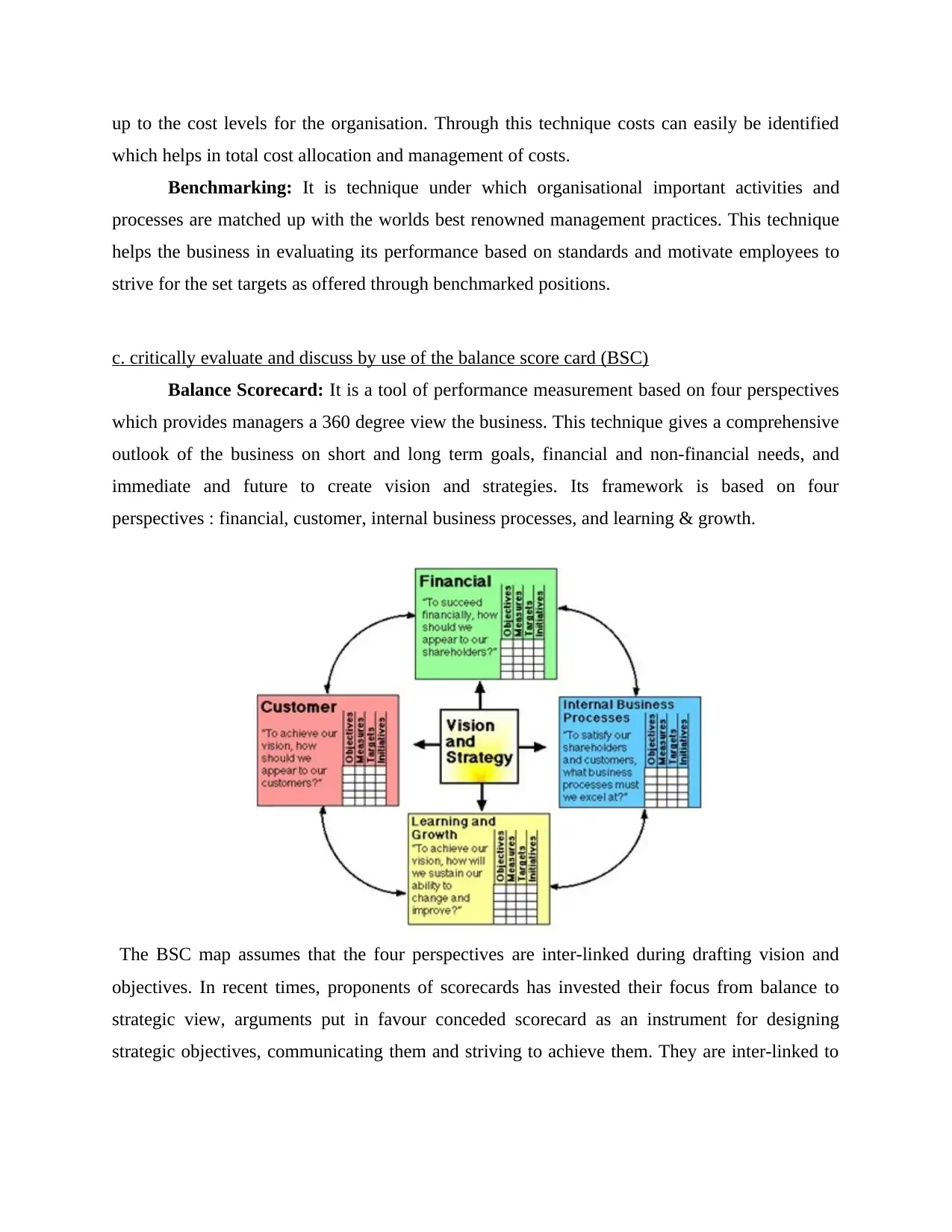
up to the cost levels for the organisation. Through this technique costs can easily be identified
which helps in total cost allocation and management of costs.
Benchmarking: It is technique under which organisational important activities and
processes are matched up with the worlds best renowned management practices. This technique
helps the business in evaluating its performance based on standards and motivate employees to
strive for the set targets as offered through benchmarked positions.
c. critically evaluate and discuss by use of the balance score card (BSC)
Balance Scorecard: It is a tool of performance measurement based on four perspectives
which provides managers a 360 degree view the business. This technique gives a comprehensive
outlook of the business on short and long term goals, financial and non-financial needs, and
immediate and future to create vision and strategies. Its framework is based on four
perspectives : financial, customer, internal business processes, and learning & growth.
The BSC map assumes that the four perspectives are inter-linked during drafting vision and
objectives. In recent times, proponents of scorecards has invested their focus from balance to
strategic view, arguments put in favour conceded scorecard as an instrument for designing
strategic objectives, communicating them and striving to achieve them. They are inter-linked to
which helps in total cost allocation and management of costs.
Benchmarking: It is technique under which organisational important activities and
processes are matched up with the worlds best renowned management practices. This technique
helps the business in evaluating its performance based on standards and motivate employees to
strive for the set targets as offered through benchmarked positions.
c. critically evaluate and discuss by use of the balance score card (BSC)
Balance Scorecard: It is a tool of performance measurement based on four perspectives
which provides managers a 360 degree view the business. This technique gives a comprehensive
outlook of the business on short and long term goals, financial and non-financial needs, and
immediate and future to create vision and strategies. Its framework is based on four
perspectives : financial, customer, internal business processes, and learning & growth.
The BSC map assumes that the four perspectives are inter-linked during drafting vision and
objectives. In recent times, proponents of scorecards has invested their focus from balance to
strategic view, arguments put in favour conceded scorecard as an instrument for designing
strategic objectives, communicating them and striving to achieve them. They are inter-linked to
Paraphrase This Document
Need a fresh take? Get an instant paraphrase of this document with our AI Paraphraser
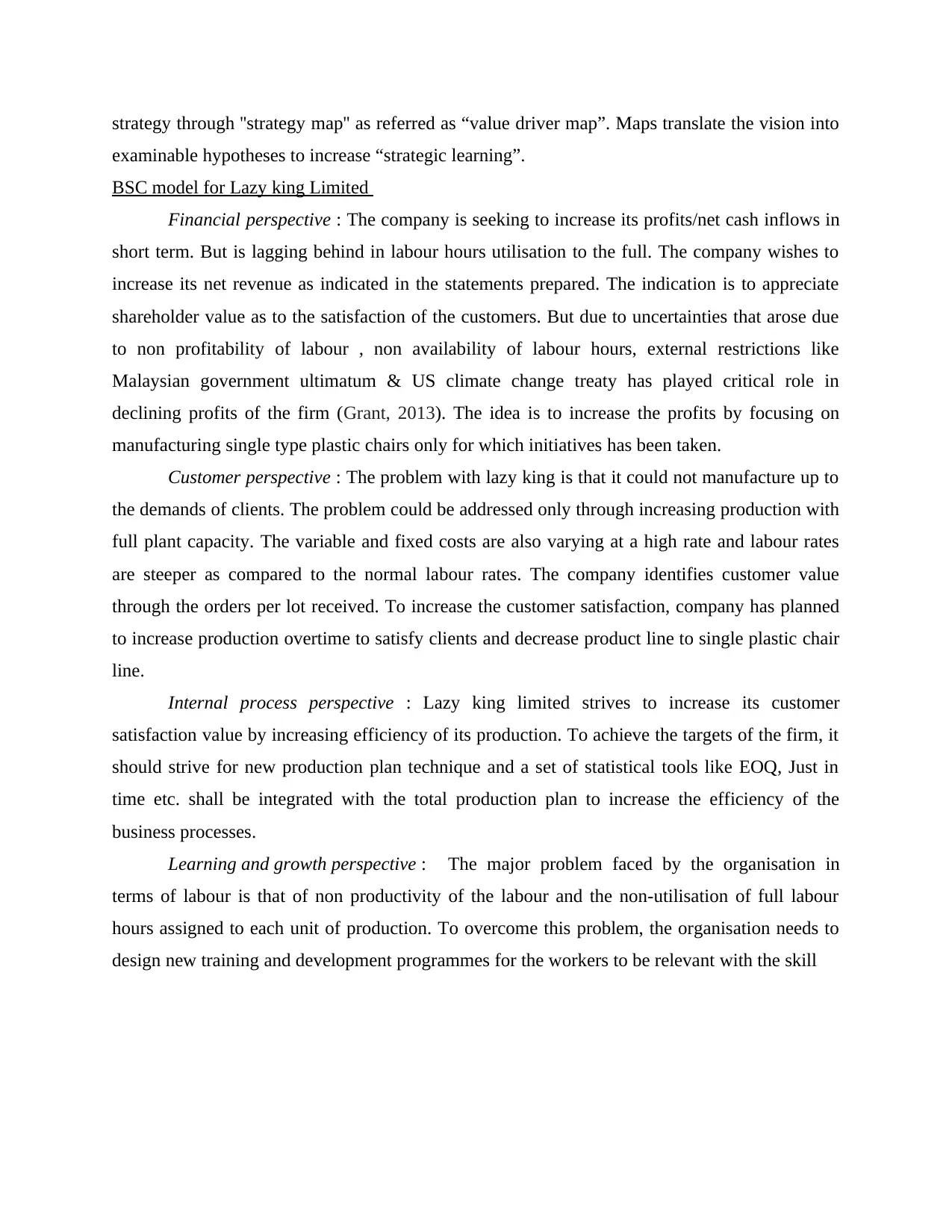
strategy through ''strategy map'' as referred as “value driver map”. Maps translate the vision into
examinable hypotheses to increase “strategic learning”.
BSC model for Lazy king Limited
Financial perspective : The company is seeking to increase its profits/net cash inflows in
short term. But is lagging behind in labour hours utilisation to the full. The company wishes to
increase its net revenue as indicated in the statements prepared. The indication is to appreciate
shareholder value as to the satisfaction of the customers. But due to uncertainties that arose due
to non profitability of labour , non availability of labour hours, external restrictions like
Malaysian government ultimatum & US climate change treaty has played critical role in
declining profits of the firm (Grant, 2013). The idea is to increase the profits by focusing on
manufacturing single type plastic chairs only for which initiatives has been taken.
Customer perspective : The problem with lazy king is that it could not manufacture up to
the demands of clients. The problem could be addressed only through increasing production with
full plant capacity. The variable and fixed costs are also varying at a high rate and labour rates
are steeper as compared to the normal labour rates. The company identifies customer value
through the orders per lot received. To increase the customer satisfaction, company has planned
to increase production overtime to satisfy clients and decrease product line to single plastic chair
line.
Internal process perspective : Lazy king limited strives to increase its customer
satisfaction value by increasing efficiency of its production. To achieve the targets of the firm, it
should strive for new production plan technique and a set of statistical tools like EOQ, Just in
time etc. shall be integrated with the total production plan to increase the efficiency of the
business processes.
Learning and growth perspective : The major problem faced by the organisation in
terms of labour is that of non productivity of the labour and the non-utilisation of full labour
hours assigned to each unit of production. To overcome this problem, the organisation needs to
design new training and development programmes for the workers to be relevant with the skill
examinable hypotheses to increase “strategic learning”.
BSC model for Lazy king Limited
Financial perspective : The company is seeking to increase its profits/net cash inflows in
short term. But is lagging behind in labour hours utilisation to the full. The company wishes to
increase its net revenue as indicated in the statements prepared. The indication is to appreciate
shareholder value as to the satisfaction of the customers. But due to uncertainties that arose due
to non profitability of labour , non availability of labour hours, external restrictions like
Malaysian government ultimatum & US climate change treaty has played critical role in
declining profits of the firm (Grant, 2013). The idea is to increase the profits by focusing on
manufacturing single type plastic chairs only for which initiatives has been taken.
Customer perspective : The problem with lazy king is that it could not manufacture up to
the demands of clients. The problem could be addressed only through increasing production with
full plant capacity. The variable and fixed costs are also varying at a high rate and labour rates
are steeper as compared to the normal labour rates. The company identifies customer value
through the orders per lot received. To increase the customer satisfaction, company has planned
to increase production overtime to satisfy clients and decrease product line to single plastic chair
line.
Internal process perspective : Lazy king limited strives to increase its customer
satisfaction value by increasing efficiency of its production. To achieve the targets of the firm, it
should strive for new production plan technique and a set of statistical tools like EOQ, Just in
time etc. shall be integrated with the total production plan to increase the efficiency of the
business processes.
Learning and growth perspective : The major problem faced by the organisation in
terms of labour is that of non productivity of the labour and the non-utilisation of full labour
hours assigned to each unit of production. To overcome this problem, the organisation needs to
design new training and development programmes for the workers to be relevant with the skill
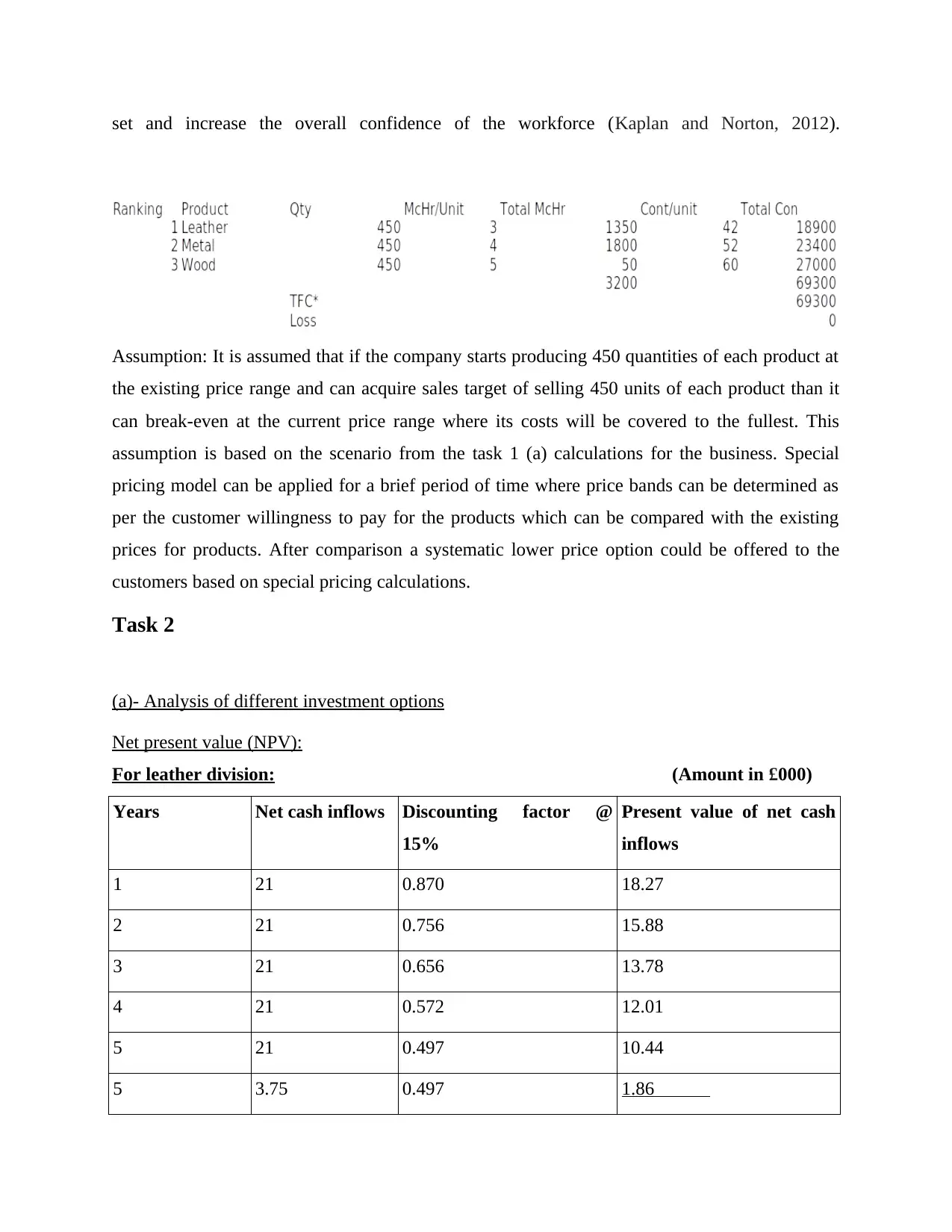
set and increase the overall confidence of the workforce (Kaplan and Norton, 2012).
Assumption: It is assumed that if the company starts producing 450 quantities of each product at
the existing price range and can acquire sales target of selling 450 units of each product than it
can break-even at the current price range where its costs will be covered to the fullest. This
assumption is based on the scenario from the task 1 (a) calculations for the business. Special
pricing model can be applied for a brief period of time where price bands can be determined as
per the customer willingness to pay for the products which can be compared with the existing
prices for products. After comparison a systematic lower price option could be offered to the
customers based on special pricing calculations.
Task 2
(a)- Analysis of different investment options
Net present value (NPV):
For leather division: (Amount in £000)
Years Net cash inflows Discounting factor @
15%
Present value of net cash
inflows
1 21 0.870 18.27
2 21 0.756 15.88
3 21 0.656 13.78
4 21 0.572 12.01
5 21 0.497 10.44
5 3.75 0.497 1.86
Assumption: It is assumed that if the company starts producing 450 quantities of each product at
the existing price range and can acquire sales target of selling 450 units of each product than it
can break-even at the current price range where its costs will be covered to the fullest. This
assumption is based on the scenario from the task 1 (a) calculations for the business. Special
pricing model can be applied for a brief period of time where price bands can be determined as
per the customer willingness to pay for the products which can be compared with the existing
prices for products. After comparison a systematic lower price option could be offered to the
customers based on special pricing calculations.
Task 2
(a)- Analysis of different investment options
Net present value (NPV):
For leather division: (Amount in £000)
Years Net cash inflows Discounting factor @
15%
Present value of net cash
inflows
1 21 0.870 18.27
2 21 0.756 15.88
3 21 0.656 13.78
4 21 0.572 12.01
5 21 0.497 10.44
5 3.75 0.497 1.86
⊘ This is a preview!⊘
Do you want full access?
Subscribe today to unlock all pages.

Trusted by 1+ million students worldwide

72.24
Less: Initial investment = 75
Net present value = (2.76)
For Wood division: (Amount in £000)
Years Net cash inflows Discounting factor @
15%
Present value of net cash
inflows
1 32 0.870 27.84
2 23 0.756 17.39
3 20 0.656 13.12
4 17 0.572 9.72
5 12 0.497 5.96
5 3.75 0.497 1.86
75.89
Less: Initial investment = 75
Net present value = 0.89
For Steel division: (Amount in £000)
Years Net cash inflows Discounting factor @
15%
Present value of net cash
inflows
1 12 0.870 10.44
2 17 0.756 12.85
3 20 0.656 13.12
4 23 0.572 13.16
5 32 0.497 15.9
5 3.75 0.497 1.86
Less: Initial investment = 75
Net present value = (2.76)
For Wood division: (Amount in £000)
Years Net cash inflows Discounting factor @
15%
Present value of net cash
inflows
1 32 0.870 27.84
2 23 0.756 17.39
3 20 0.656 13.12
4 17 0.572 9.72
5 12 0.497 5.96
5 3.75 0.497 1.86
75.89
Less: Initial investment = 75
Net present value = 0.89
For Steel division: (Amount in £000)
Years Net cash inflows Discounting factor @
15%
Present value of net cash
inflows
1 12 0.870 10.44
2 17 0.756 12.85
3 20 0.656 13.12
4 23 0.572 13.16
5 32 0.497 15.9
5 3.75 0.497 1.86
Paraphrase This Document
Need a fresh take? Get an instant paraphrase of this document with our AI Paraphraser
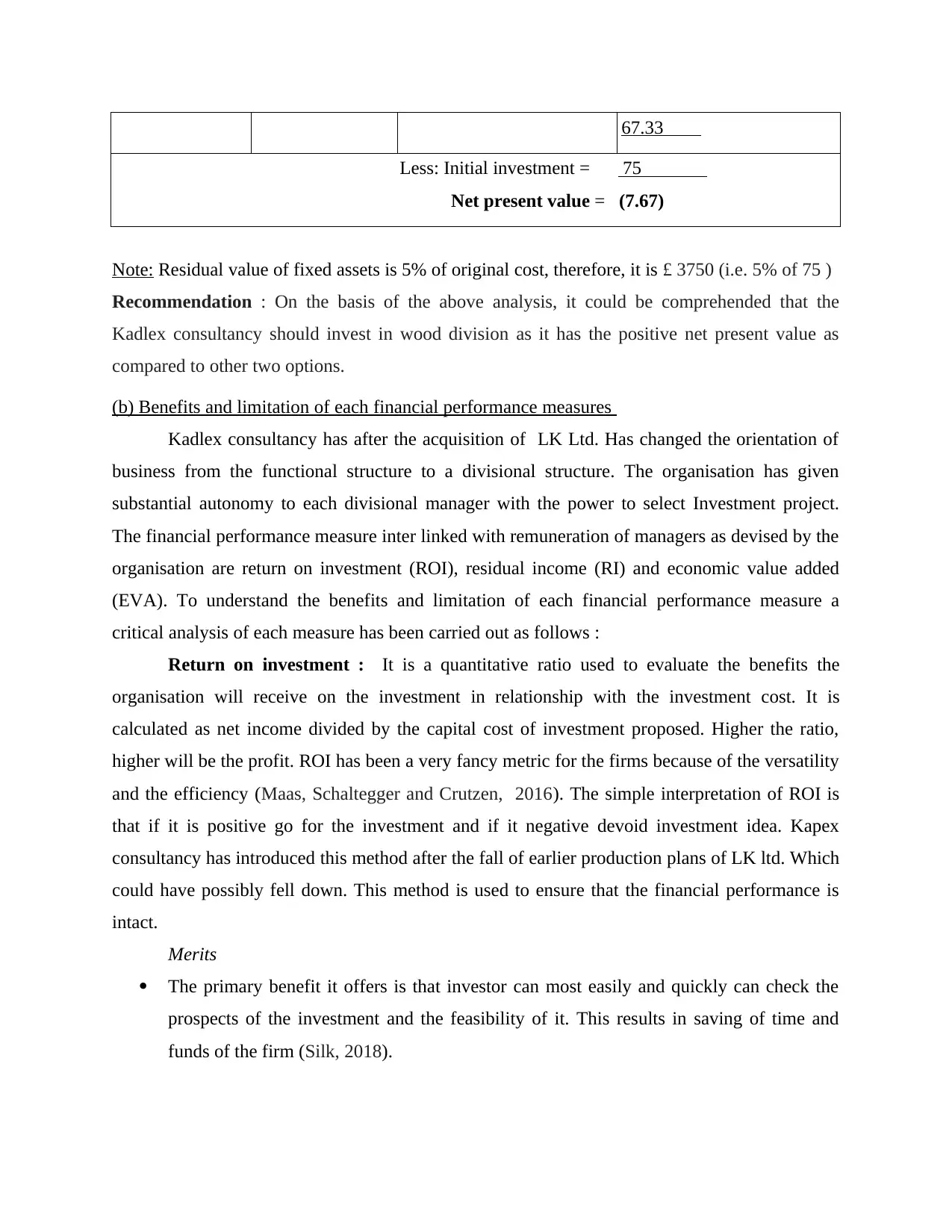
67.33
Less: Initial investment = 75
Net present value = (7.67)
Note: Residual value of fixed assets is 5% of original cost, therefore, it is £ 3750 (i.e. 5% of 75 )
Recommendation : On the basis of the above analysis, it could be comprehended that the
Kadlex consultancy should invest in wood division as it has the positive net present value as
compared to other two options.
(b) Benefits and limitation of each financial performance measures
Kadlex consultancy has after the acquisition of LK Ltd. Has changed the orientation of
business from the functional structure to a divisional structure. The organisation has given
substantial autonomy to each divisional manager with the power to select Investment project.
The financial performance measure inter linked with remuneration of managers as devised by the
organisation are return on investment (ROI), residual income (RI) and economic value added
(EVA). To understand the benefits and limitation of each financial performance measure a
critical analysis of each measure has been carried out as follows :
Return on investment : It is a quantitative ratio used to evaluate the benefits the
organisation will receive on the investment in relationship with the investment cost. It is
calculated as net income divided by the capital cost of investment proposed. Higher the ratio,
higher will be the profit. ROI has been a very fancy metric for the firms because of the versatility
and the efficiency (Maas, Schaltegger and Crutzen, 2016). The simple interpretation of ROI is
that if it is positive go for the investment and if it negative devoid investment idea. Kapex
consultancy has introduced this method after the fall of earlier production plans of LK ltd. Which
could have possibly fell down. This method is used to ensure that the financial performance is
intact.
Merits
The primary benefit it offers is that investor can most easily and quickly can check the
prospects of the investment and the feasibility of it. This results in saving of time and
funds of the firm (Silk, 2018).
Less: Initial investment = 75
Net present value = (7.67)
Note: Residual value of fixed assets is 5% of original cost, therefore, it is £ 3750 (i.e. 5% of 75 )
Recommendation : On the basis of the above analysis, it could be comprehended that the
Kadlex consultancy should invest in wood division as it has the positive net present value as
compared to other two options.
(b) Benefits and limitation of each financial performance measures
Kadlex consultancy has after the acquisition of LK Ltd. Has changed the orientation of
business from the functional structure to a divisional structure. The organisation has given
substantial autonomy to each divisional manager with the power to select Investment project.
The financial performance measure inter linked with remuneration of managers as devised by the
organisation are return on investment (ROI), residual income (RI) and economic value added
(EVA). To understand the benefits and limitation of each financial performance measure a
critical analysis of each measure has been carried out as follows :
Return on investment : It is a quantitative ratio used to evaluate the benefits the
organisation will receive on the investment in relationship with the investment cost. It is
calculated as net income divided by the capital cost of investment proposed. Higher the ratio,
higher will be the profit. ROI has been a very fancy metric for the firms because of the versatility
and the efficiency (Maas, Schaltegger and Crutzen, 2016). The simple interpretation of ROI is
that if it is positive go for the investment and if it negative devoid investment idea. Kapex
consultancy has introduced this method after the fall of earlier production plans of LK ltd. Which
could have possibly fell down. This method is used to ensure that the financial performance is
intact.
Merits
The primary benefit it offers is that investor can most easily and quickly can check the
prospects of the investment and the feasibility of it. This results in saving of time and
funds of the firm (Silk, 2018).
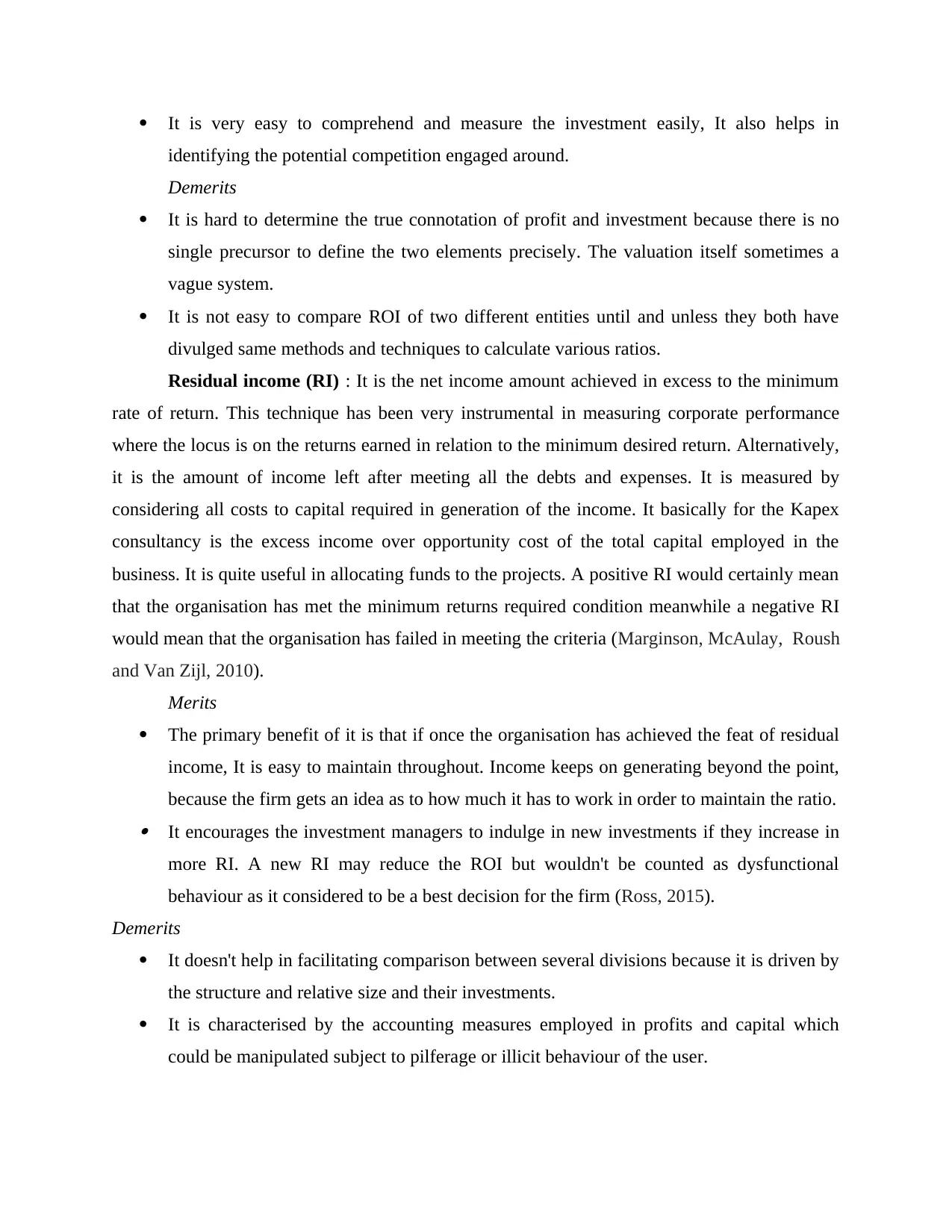
It is very easy to comprehend and measure the investment easily, It also helps in
identifying the potential competition engaged around.
Demerits
It is hard to determine the true connotation of profit and investment because there is no
single precursor to define the two elements precisely. The valuation itself sometimes a
vague system.
It is not easy to compare ROI of two different entities until and unless they both have
divulged same methods and techniques to calculate various ratios.
Residual income (RI) : It is the net income amount achieved in excess to the minimum
rate of return. This technique has been very instrumental in measuring corporate performance
where the locus is on the returns earned in relation to the minimum desired return. Alternatively,
it is the amount of income left after meeting all the debts and expenses. It is measured by
considering all costs to capital required in generation of the income. It basically for the Kapex
consultancy is the excess income over opportunity cost of the total capital employed in the
business. It is quite useful in allocating funds to the projects. A positive RI would certainly mean
that the organisation has met the minimum returns required condition meanwhile a negative RI
would mean that the organisation has failed in meeting the criteria (Marginson, McAulay, Roush
and Van Zijl, 2010).
Merits
The primary benefit of it is that if once the organisation has achieved the feat of residual
income, It is easy to maintain throughout. Income keeps on generating beyond the point,
because the firm gets an idea as to how much it has to work in order to maintain the ratio. It encourages the investment managers to indulge in new investments if they increase in
more RI. A new RI may reduce the ROI but wouldn't be counted as dysfunctional
behaviour as it considered to be a best decision for the firm (Ross, 2015).
Demerits
It doesn't help in facilitating comparison between several divisions because it is driven by
the structure and relative size and their investments.
It is characterised by the accounting measures employed in profits and capital which
could be manipulated subject to pilferage or illicit behaviour of the user.
identifying the potential competition engaged around.
Demerits
It is hard to determine the true connotation of profit and investment because there is no
single precursor to define the two elements precisely. The valuation itself sometimes a
vague system.
It is not easy to compare ROI of two different entities until and unless they both have
divulged same methods and techniques to calculate various ratios.
Residual income (RI) : It is the net income amount achieved in excess to the minimum
rate of return. This technique has been very instrumental in measuring corporate performance
where the locus is on the returns earned in relation to the minimum desired return. Alternatively,
it is the amount of income left after meeting all the debts and expenses. It is measured by
considering all costs to capital required in generation of the income. It basically for the Kapex
consultancy is the excess income over opportunity cost of the total capital employed in the
business. It is quite useful in allocating funds to the projects. A positive RI would certainly mean
that the organisation has met the minimum returns required condition meanwhile a negative RI
would mean that the organisation has failed in meeting the criteria (Marginson, McAulay, Roush
and Van Zijl, 2010).
Merits
The primary benefit of it is that if once the organisation has achieved the feat of residual
income, It is easy to maintain throughout. Income keeps on generating beyond the point,
because the firm gets an idea as to how much it has to work in order to maintain the ratio. It encourages the investment managers to indulge in new investments if they increase in
more RI. A new RI may reduce the ROI but wouldn't be counted as dysfunctional
behaviour as it considered to be a best decision for the firm (Ross, 2015).
Demerits
It doesn't help in facilitating comparison between several divisions because it is driven by
the structure and relative size and their investments.
It is characterised by the accounting measures employed in profits and capital which
could be manipulated subject to pilferage or illicit behaviour of the user.
⊘ This is a preview!⊘
Do you want full access?
Subscribe today to unlock all pages.

Trusted by 1+ million students worldwide
1 out of 15
Related Documents
Your All-in-One AI-Powered Toolkit for Academic Success.
+13062052269
info@desklib.com
Available 24*7 on WhatsApp / Email
![[object Object]](/_next/static/media/star-bottom.7253800d.svg)
Unlock your academic potential
Copyright © 2020–2026 A2Z Services. All Rights Reserved. Developed and managed by ZUCOL.





